Abstract
In this article, a multi-port non-isolated converter is implemented for renewable energy applications. High voltage gain is accomplished with a switched capacitor and coupled inductor, and power transfer between the inputs, battery, and load can be realized using three power switches. The power collected in the leakage inductance is reused to decrease the voltage stress on the power switch. Various functioning periods are also examined, and design requirements are offered. The proposed converter uses fewer parts to realize power flows and obtain high voltage gain compared to comparable converters. Additionally, under partial shading conditions, the traditional maximum power point tracking (MPPT) approaches are not able to collect the global maximum power point (MPP) from the numerous local MPPs. This work proposes an artificial neural-network-based MPPT technique with variable step size for tracing speed, MPP oscillations, and operating efficiency. The proposed converter experiment is also constructed and successfully tested in a laboratory environment.
1. Introduction
The primary clean energy technologies—solar, wind, biomass, and tidal energy—have emerged as the proper response to the current global energy issue. Recent decades have seen widespread use of renewable energy sources [1,2]. To utilize solar, fuel cell, and wind energy in distribution generation (DG) systems, regions with conventional energy shortages need to consider hybrid distributed generation systems (HDGs), which benefit from both renewable energy systems (RES) and DG systems. In various research, a two-input single-output technique has been designed to build such a hybrid RES [3]. Various technological difficulties are confronted and resolutions are discussed in [4]. Multi-port converters are utilized in hybrid energy systems to integrate sources with various voltage and power ranges [5,6]. The power system’s stability, consistency, endurance, and power quality can be impacted by the variable renewable and unpredictable renewable energy sources (RESs) [7]. The output from the RESs will be smoothed, and energy storage systems (ESSs) are typically used [8]. The power system response and a techno-economic and ecological evaluation of the micro grid model are also provided [9]. The performance evaluation of the different dispatch methodologies was conducted based on the techno-economic environmental perspectives [10]. A novel design of a two-stage decentralized controller that simultaneously controls the DC bus voltage and load voltage of a hybrid micro grid against the unknown generation and loads was presented [11]. Two off-grid hybrid renewable energy systems (HRES) have been optimized [12] and evaluated using wind turbines, battery storages, solar panels, and diesel generators, considering five dispatch control strategies. The evolutions of renewable energy resources with the problem statement and solutions continued with the optimization control techniques for the islanded hybrid micro grid and hybrid renewable energy systems followed by the correlation between the optimization techniques and control strategies [13]. Multi-port converters (MPC) incorporate for transmitting between RES, ESS, and the load to produce a necessary voltage to satisfy the power demand, as illustrated in Figure 1. This reduces the size, cost, and complexity of the RESs and enhances efficiency.
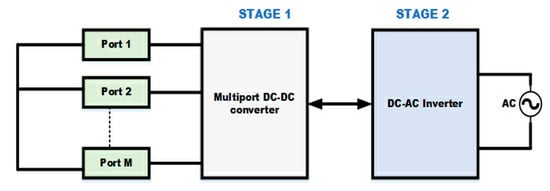
Figure 1.
Block diagram of a multi-port converter.
Several uses of multi-port converters are being explored, including the incorporation of renewable energy into residences, electric vehicles (EVs), power sources for home appliances, and on-chip sources for portable electronic devices. The MPCs are categorized as either isolated or non-isolated type [14]. The isolated-type MPC uses a transformer among many secondary windings to connect to different loads. The subsequent outputs are connected to extra secondary windings, apart from the one output that is carefully regulated [15]. In non-isolated MPCs, there is no galvanic separation between different ports [16]. Additionally, they are further divided into single and multiple inductors depending on the number of inductors [17]. By customizing the submodule quantity in various upper arms, the voltage levels at several DC ports may be flexibly modified [18]. An efficient and comprehensive method for creating MICs that may give individual or simultaneous energy to the load is explained [19].
Magnetically coupled inductor topologies are described in [20], which minimize the normalized voltage stress across the semiconductors and enhance the converter’s output voltage gain via energy transfer stored in coupled inductance. Therefore, switching must be avoided by using a clamping circuit. Various DC-DC converters are available, including a high-gain DC-DC converter [21], because of which the semiconductors experience low voltage stress and a high gain at a minimum duty cycle. However, because it uses hard switching, there are greater losses, which reduce system efficiency. In [22], a single switch DC-DC converter is used to attain greater gain with great efficiency. The main disadvantage is that it contains many passive parts, contributing to the complexity and increasing the system’s cost. A DC-DC step-up converter with an impedance network [23] prevents instability imposed by inductor saturation by achieving a maximum gain with a few diodes and a low-duty cycle. The converter’s reduced efficiency is its main disadvantage. The converter can be enlarged, which gives great voltage gain at low duty ratios, and prevents switching capacitors from severe voltage stress. However, since it contains so many active and passive parts, the converter is larger and more costly. Even though there is less voltage stress across the active elements, the device switches on and off quickly [24]. It has many components and considerable losses, contributing to its large size and high cost.
Three different topologies for three-port converters (TPCs) can be identified: fully isolated TPCs (FITPCs) [25], partly isolated TPCs (PITPCs) [26], and non-isolated TPCs (NITPCs) [27,28,29,30]. The non-isolated TPCs are commonly utilized in the ESS and have a compact size and high efficiency, whereas FITPCs and PITPCs have complex structures and poor performance. Due to the low voltage of RESs and ESSs, power converters are needed to boost the gain. An analysis of a non-isolated converter with high gain that may balance automatically when there is an imbalance in the load [31]. An MPC [32] utilizes a single-leg active switching component to perform multiple functions, including controlling and regulating output power. The converter mentioned above employs more passive components than the traditional buck–boost converter. DC-DC converters with non-isolated multiple inputs and multiple outputs are described [33] as a unidirectional converter designed for photovoltaic (PV) applications. The multi-input single-output (MISO) n-stage converter’s drawback [34] is that (n − 1) forms perform the buck–boost operation, and stage nth serves as a step-up converter, always transmitting energy from the input to output. The non-isolated MPC with a single inductor can integrate one active switch for various load devices in low-power applications [35].
To achieve soft switching, a non-isolated MPC with dual greater boost converters designed with active clamp circuits, switched capacitors, and two coupled inductors were proposed [36]. Moreover, high component counts are utilized. To decrease the voltage stress on the primary switch, a higher-integrated TPC with a lossless passive snubber circuit has been provided [37]. Furthermore, there is excessive use of semiconductor power devices. The non-isolated multi-port converter has a reconfigurable construction and can be used as a step-up/down converter; however, the battery is not grounded along with the input [38]. A multi-port non-isolated converter with a single magnetic element was proposed to achieve high voltage gain. Leakage inductance energy can be recycled to the output. Thus, the reverse-recovery problem and electromagnetic interference noise are significantly reduced. Therefore, several elements are required to obtain significant voltage gain [39]. Two extendable non-isolated TPCs were constructed to simplify the complexity and obtain greater gain with fewer devices [40,41]. A multi-port DC-DC converter that contains two coupled inductors and a lot of switches has been proposed [37]; this converter has a large volume and expensive manufacturing costs. One of the drawbacks of this converter is that it has greater voltage stress across the switches on the MPC [42], which has low voltage gain. A converter with a single input and multiple outputs has been proposed [43], but it has many switches with high voltage stresses. Despite the benefits of the multi-port converter presented in [44], it is not connected at a common point, which restricts its functionality.
A comparison of multi-port converters for renewable energy applications using non-isolated topologies was described [45]. Non-isolated multi-port converter topologies are the better solution to reduce the cost of converters in renewable systems. The bidirectional port in most existing four-port converters is only designed for the battery, i.e., the battery is charged by the RES and discharged to the DC link. Furthermore, the polarity of the battery current is changed within a switching period. Such a high-frequency charge/discharge has a negative effect on the battery’s lifetime. Due to the lack of a bidirectional port at the DC-Link, the energy in the micro grid cannot be stored in the battery. The ‘use or waste’ issue cannot be solved when the micro grid works in the island mode. The performance and analysis of the modified high-voltage DC-DC converter were explained [46].
Temperature and irradiation affect the solar PV’s output, which is not constant [47]. Consequently, it is crucial to take out the greatest power from the PV module, which is maximum power point tracking (MPPT) [48], so that the PV panels can generate effectively, despite numerous environmental changes. A DC-DC converter significantly contributes to handling higher power when the MPPT is present in a system due to how the duty cycle changes [49]. In many applications, it is necessary to associate several renewable energy sources of dissimilar types (e.g., solar PV and wind) and integrate them into a micro grid.
A control strategy is necessary for a PV-fed inverter to generate a constant DC voltage. Numerous approaches, including practical swarm optimization (PSO), fuzzy genetic algorithms, and artificial intelligence (AI), have recently been used to have an automatic control based on the training data to manage desired voltage [50]. It is remarkable to choose the MPPT methodology for appropriate application because each method has advantages and disadvantages of its own. In GAs, transformation and intersection are used to create competing arrangements in the population, making the method a randomized heuristic inquiry technique. Furthermore, the benefits of the health goal capability are used for simplification, making GA both critical and straightforward. In addition, GA may not converge on a global ideal, especially in populations with a large number of people and clear execution benchmarks. GAs necessitate background data, which have been found in learning and inferred health-related functions: new rules are formed using the examples and patterns from the previous searches. However, fuzzy controllers can be used to show frameworks that are difficult due to ambiguous quality boundaries. In ANN, the processing time is higher for large neural networks. The efficiency of output depends highly on the training process. FLC allows for better, more efficient, and cheaper machine control. While FLC’s lack of precision has been questioned, the results are still passable, even when dealing with imperfect data. FLC is crucial for making accurate predictions. FLC is flexible because it may be used in various contexts and considers both implicit and explicit data, computation, and translation. Therefore, FLC’s ease of use and flexibility are its primary selling points for CR and similar continuous applications. FLC may be used to identify patterns even when the data is noisy, inconsistent, or unclear. Hence, applying a fuzzy logic controller (FLC) eliminates the problems of artificial neural network (ANN) and genetic algorithm (GA).A lower MPP settling time, a simpler design, and high dynamic responsiveness at various PSCs are the benefits of FLC controllers. The power point tracking controller for ANFIS is utilized to step up the PV voltage. Comparing the ANFIS to the FLC, the MPP tracking efficiency is higher. To train the network, however, requires a very knowledgeable individual. An FLC for MIDC parallel configuration addresses the issues of electric vehicle application and energy storage of a ship, respectively. Power budgeting is described as where the whole system needs one dedicated voltage controller and several current controllers to satisfy the output power. A stand-alone hybrid renewable energy system (HRES) was presented, including a fuzzy logic-based controller design for power management (i.e., a fuzzy logic-based energy management system of stand-alone renewable energy for a remote area power system). An intelligent fuzzy controller-based high-gain non-isolated multi-input DC-DC converter is described. The comparative analysis of a positive output super lift Luo converter with a fuzzy logic-based controller is presented. The neural network controller is proficient in addressing uncertainty in training and learning from the process. A radial basic function network has faster convergence behavior than a conventional neural network, but with a simpler network configuration due to their inherent capability to learn the behavior of systems from a restricted number of samples. Conventional techniques cannot extract global MPP (GMPP) in partial shading conditions [51]. Several MPPT methodologies evaluate the converter’s performance and the variable step size radial basis function network (VSS-RBFN) MPPT [52,53].
The proposed work describes a non-isolated MPC with a greater gain for using renewable energy sources in application. The proposed converter has the apparent characteristics listed below.
- Approximately three power switches are required to obtain power transmitting between the input, battery, and load port.
- The common ground between the input, battery, and load port increases reliability.
- A greater gain with a single-coupled inductor is achievable without using an excessively high duty cycle.
- To reduce the main power switch’s voltage spike, leakage inductance can be recycled via the intermediate capacitor circuit.
2. Proposed Converter
According to Figure 2, the proposed non-isolated multi-port converter is implemented. The voltage of a renewable energy source is denoted by Vin, while the voltage of a battery is denoted by VB. The capacitor C3 is required to reuse the energy held in the leakage inductance and clamp the active switches’ voltage stress. The secondary-side-coupled inductor Ns, diode D4, capacitor C4, and additional switching capacitor circuit collaborate to generate the additional voltage gain.
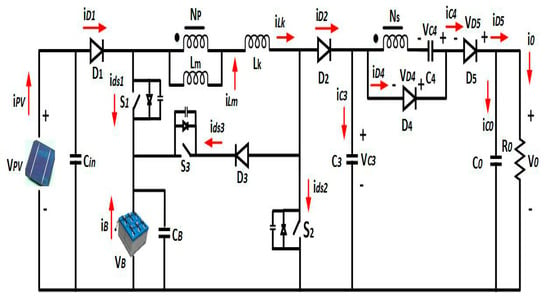
Figure 2.
Proposed multi-port converter.
A few assumptions are made to analyze the circuit easily:
- Continuous conduction mode (CCM) operation is used to maintain the non-isolated multi-port converter at a steady state.
- All semiconductor devices are recognized as ideal except for body diodes and MOSFET output capacitance.
- The coupled inductor turn ratio is described as Np:NS = 1:n.
- In one switching cycle, VPV, VB, VC3, VC4, and VCo can be regarded as fixed voltages due to the large capacitors of Cin, CB, C3, C4, and C0.
Operating Principle of the Proposed Converter
The load is provided energy at this interval by VPV and VB. The converter’s primary switches are S1 and S2, and S3 is generally off. The current flow routes of the operating modes are depicted in Figure 3 and Figure 4, respectively. This is a description of the operational modes:
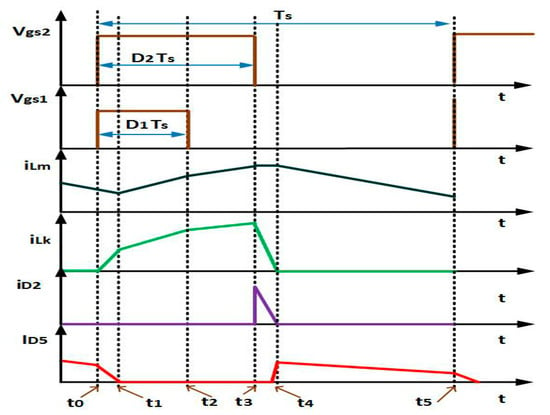
Figure 3.
Waveform of the steady state in the proposed converter.
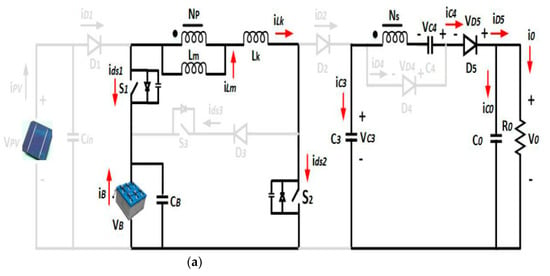
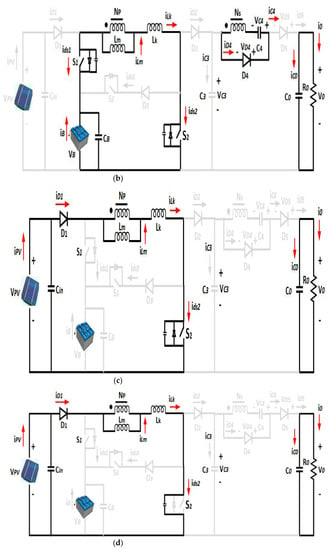
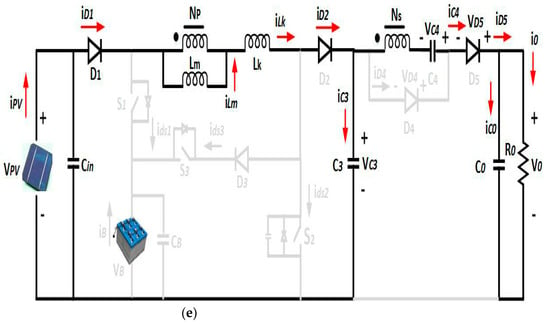
Figure 4.
Proposed converter operating processes (a) Mode I (b) Mode II (c) Mode III (d) Mode IV (e) Mode V.
Mode I (t0–t1) [Figure 4a]: When iLk > 0, iLm > 0, and iLk < iLm are present, Vgs2 and Vgs1 achieve a high value. Diode D1 is OFF since VB exceeds VPV. Energy is given to Lk by VB. The load is supplied with energy by VC3, Lm, and VC4. When iLm = iLk at time t1, this mode ends.
Mode II (t1–t2) [Figure 4b]: With iLm > 0, iLk > 0, and iLm = iLk, the Vgs2 and Vgs1 are maximum. The Lm and Lk receive energy from VB, which causes a linear increase in iLm and iLk. A switched capacitor circuit is created by the components Ns, D4, and C4, and VC4 is equal to nVB. When Vgs1 is low at time t2, this mode terminates.
Mode III (t2–t3) [Figure 4c]: When Vgs2 is high, in addition to iLk > 0, iLm > 0, and iLm = iLk, Vgs1 is low. The Lm and Lk receive energy from Vin, which causes a linear increase in iLm and iLk. When Vgs2 at time t3 is low, this mode terminates.
Mode IV (t3–t4) [Figure 4d]: The Vgs1 and Vgs2 are low. As a result of the iLk charging, the output capacitor Coss2 of S2, Vds2 increases. When Vds2 = VC3 at t4, the mode terminates.
Mode V (t4–t5) [Figure 4e]: The Vgs1 and Vgs2 are low. Since iLm > 0, it decreases linearly. The VC3 clamps Vds2. The capacitor, C3, receives energy from Vin and Lm. The load is supplied with energy by VC3, Lm, and VC4. This mode terminates when t5Vgs2 and Vgs1 are high.
When S2 and S1 are on,
When S2 is on and S1 is off,
When S2 and S1 are off,
The voltage gain can be attained by applying the magnetic inductor Lm volt–balance principle.
3. Design Considerations
3.1. Capacitor Design
Capacitances can be calculated from the capacitors’ voltage ripple [46] and can be expressed as follows:
where capacitors C3, C4, and CB, the voltage ripple are ΔVC3, ΔVC4, and ΔVCB, respectively.
3.2. Coupled Inductor Design
When using CCM, a circuit performs dynamically, independently of load, and with excellent stability.
It is possible to derive the Lm current ripple as follows:
Since Lm is continuous, by applying the concepts of the current balance, identify the time interval during which the average currents through the capacitors are equal to zero. As a result, the preceding expression can be expressed as
Additionally, the diode’s average currents under the situation are written as follows using charge balance:
By applying KCL it is possible to calculate the average current through the Lm as
The average current in (14) is equal to half of the current ripple in (9). Thus, the following equation can be written as
where is the load current in BCM.
3.3. Semiconductor Voltage Stresses
The clamp circuits consist of diode D2 and capacitor C3. The switch S2 experiences a voltage stress equal to VC3. The following equation has:
The switches S2 and S3 voltage stresses are simple to obtain as
The diode voltage stresses are obtained as
4. Design of PV Control
Depending on the topology of the converter and other relevant circuit factors, different MPPT techniques are used [54,55]. Before the input capacitance Cs, the solar voltage Vpv and input current Ipv are measured. To collect the MPP at various irradiance and temperatures, the MPPT algorithm uses these two parameters. The MPP value serves as the point of reference for the solar input measured and maintained there. A voltage and a current loop are used to achieve the MPPT. The MPC output voltage is reduced as the current reference is increased. As a result, the feedback and voltage reference compensator have incorrect indications. The feedback voltage is designed for the internal comparators to prevent the output voltage from being greater than the element range; it can activate the PWM in an overvoltage condition. The I–V and P–V characteristics at constant irradiation and various temperatures may be derived by evaluating the PV current, voltage, and output power, as illustrated in Figure 5.

Figure 5.
I–V and P–V characteristics curve; constant irradiation and different temperature.
According to the series and parallel cells, short-circuit current Isc and open-circuit voltage Voc connected to the investigated PV array are given:
The current-voltage (I–V) characteristics of PV could be described as follows:
For a specified insolation level Sn and PV cell operating temperature Tc, Equation (3) can be applied.
5. Variable Step Size ANN-MPPT Algorithms
The conventional MPPT methods based on fixed step-size have a good performance. However, they are characterized by major drawbacks such as slow convergence, oscillations around the MPP, and failing to track it under rapidly changing atmospheric conditions. Speedy tracking can be achieved with larger step size, but excessive steady-state oscillations are unavoidable. At the same time, smaller step size can reduce the oscillations with slower dynamics. In solving these dilemmas, many contributions have been introduced using variable step size and significant progress has been made, where the algorithm changes the step size automatically according to the PV array characteristics. Step size should make a satisfactory trade-off between the dynamics and oscillations depending on each operational condition. Therefore, from the basic principle of MPPT, this study proposes a new variable step size MPPT algorithm characterized by more simplicity, faster response time, and fewer oscillations. The variable step size method proposed is given as follows:
where D (k) and D (k − 1) are the duty cycle for instants k and k − 1, respectively. M is the scaling factor adjusted at the sampling period to regulate the step size, and dP is the PV array output power derivate defined by dP(k) = P(k) − P(k − 1). The basic principle of the neural network MPPT controller is summarized in Table 1.

Table 1.
Basic principle of ANN-MPPT controller.
6. Proposed VSS-RBFN-Based Fuzzy Logic Controller
The proposed converter in Figure 6 uses the MPPT control to regulate the power generated by the PV panel. The P&O MPPT control method provides, as the controller’s basis [56,57], the utilization of a PV panel’s power as efficiently as possible while simultaneously under various environmental conditions. To generate the required PWM control signal for the corresponding active switch, the MPPT controller utilizes the RES output current and voltage as input. The proposed converter is developed using the variable step size radial basis functional controller (VSS-RBFC)-based fuzzy logic controller. Calculus and statistical analysis proficiency is necessary for the basic conventional neural controller. These controllers also need additional training data and storage space. The several layers of coupled neurons comprise neural structures. The nodes may be viewed as biological neurons. The data transformation or process has been completed from the input layer to the requisite output layer. Similar to this, the multilayer-related MPP controller uses a variety of hidden layers [58]. The implementation of the neural-dependent system has become more complicated.
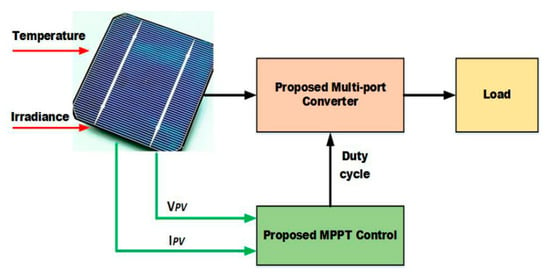
Figure 6.
Proposed PV system with MPPT controller.
Two types of supervised and unsupervised learning approaches have been used to train the network. The input side layer uses the supervising principle to assign the neural nodes their initial weights. The RBF controller is then run using an unsupervised approach, and the learning algorithm used to run it is used to update the neural weights.
Here, the input to the RBF controller is continuously varied solar insolation, sun operating temperature, maximum current and voltages, and open-circuit voltage, as illustrated in Figure 7. The proposed FLC controller and its membership function is shown in Figure 8 and Figure 9, respectively. The RBF and feed-forward neural network have many similarities, as seen in Figure 7. Nine hidden nodes, one output node, and five input neurons make up the RBF that is currently being used. The net results are as follows:
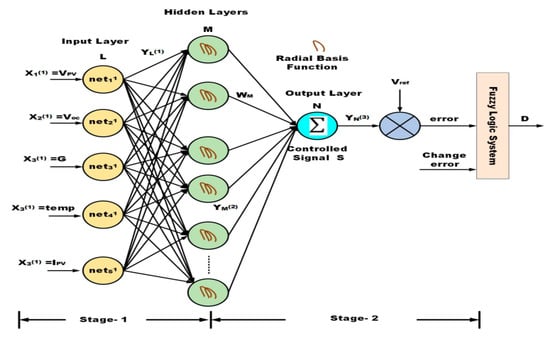
Figure 7.
Proposed RBFN-associated fuzzy logic MPPT controller.
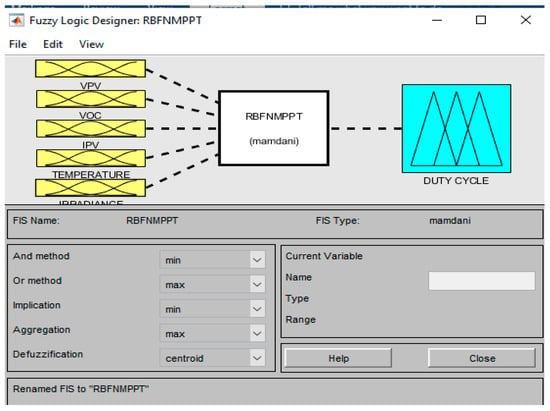
Figure 8.
Proposed RBFN-fuzzy logic controller.
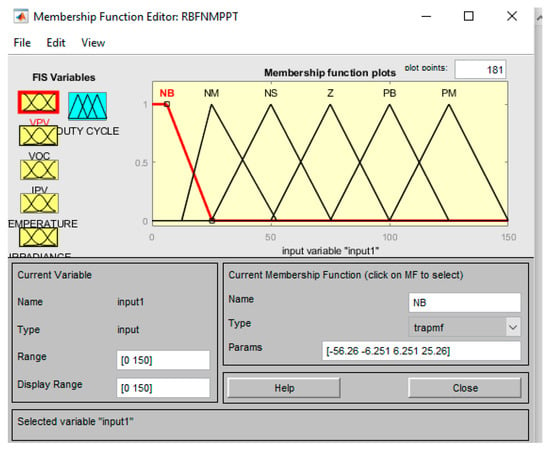
Figure 9.
Proposed RBFN-fuzzy logic controller membership function.
The term is depicted in the proposed RBFC network as an all-encompassing neuron based on Equation (29). Every layer’s standard deviation has been chosen as “my.” As the system’s Gaussian mean, the summation term from Equation (30) is chosen to be 6. Each hidden layer node functions as a unique membership value in the RBFC network in this case. The term “maximum voltage” refers to the PV system’s highest voltage set by the network’s linear activation. To feed the fuzzy system, the output signal is used. Utilizing the fuzzification block, the error and variation in the error of the maximum voltage of PV are evaluated. Using the fuzzy controller, a crisp solution is created from the collection of real-valued data [59]. For the inference block to create the if-then notion, the available value of the property is fed. The processed crisp variables are converted to actual variables using the defuzzification mechanism. Membership functions characterize fuzziness (i.e., all the information in fuzzy sets), whether the elements in fuzzy sets are discrete or continuous. Membership functions area technique to solve practical problems by experience rather than knowledge. Fuzzy inference is the process of formulating the mapping from a given input to an output using fuzzy logic. The mapping then provides a basis for making decisions or discerning patterns. Mamdani-type inference expects the output membership functions to be fuzzy sets. After the aggregation process, there is a fuzzy set for each output variable, which needs defuzzification. It is possible, and sometimes more efficient, to use a single spike as the output membership function rather than a distributed fuzzy set.
Since the multi-port converter requires a distinct D-control signal upon entry, the output of the fuzzy controller must be converted from fuzzy information to mandatory information. This process is known as defuzzification. Defuzzification is the process by which the linguistic variable used by the fuzzy logic controller is converted into a mathematical one. Defuzzification is most commonly implemented by using the centroid defuzzification technique.
Table 2 summarizes the membership functions and rules for the FLC. The FLC received the error, and different iterations of the error parameters are deduced as

Table 2.
MPPT based on FLC rules.
The problem data determine the number of input and output nodes in an RBF network, but the number of hidden nodes (15 in the demo) is a hyperparameter that must be determined by trial and error. There are 28 training items. The data were artificial and crafted, so simple linear classification techniques, such as multi class logistic regression and linear SVM, would fail. The demo program sets values for three training hyperparameters: a learning rate (0.0050), a maximum number of iterations (1000), and a single sigma value for the network (0.10). During training, the classification mean squared error slowly decreases from 0.6654 to 0.3272, indicating that training is working. After training is complete, the demo makes a prediction for a new, previously unseen data item with normalized predictor values (0.15, 0.25). The output of the trained RBF model is (0.1354, 0.3190, and 0.5455). If the three classes to predict are conservative = (1, 0, 0), moderate = (0, 1, 0), and liberal = (0, 0, 1), then the predicted class would be liberal.
7. Experimental Results
The real PV panel’s 200W hardware model and MPPT have been upgraded to accommodate the proposed converter. An OPAL RT controller was used to construct and implement the proposed converter control. The switching frequency of the DC-DC converter was selected as 10 kHz. Additionally, the maximum switch voltage is 26 V. It is possible to see low-voltage strains through the primary active switches. The hardware module of the proposed system is shown in Figure 10. Figure 11 shows the solar photovoltaic voltage, current, and power.

Figure 10.
Hardware module of the proposed system.
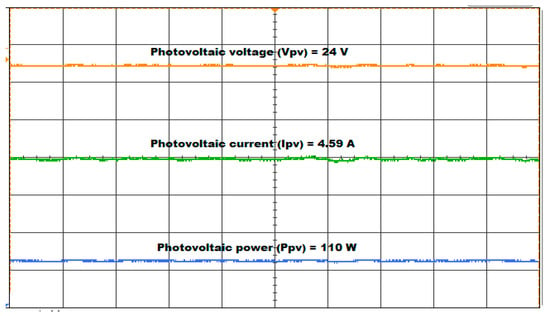
Figure 11.
Solar panel array.
Figure 12a,b shows Vgs1, Vgs2, iD2, and ids1 at different powers, respectively. It demonstrates that ids1 rises when VB supplies the load with greater energy.
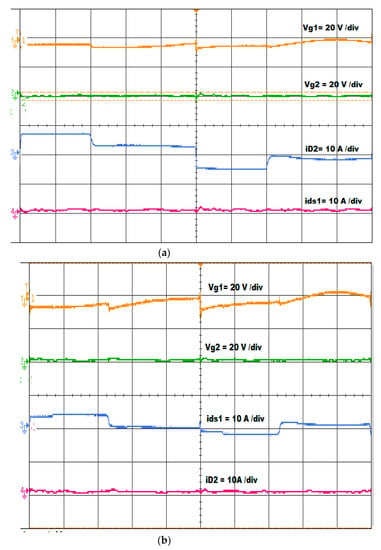
Figure 12.
(a) Vgs1, Vgs2, iD2, and ids1 waveforms, when PB = 40 W and Pin = 160 W. (b) Vgs1, Vgs2, iD2, and ids1 waveforms, when PB = 160 W and Pin = 40 W.
From Table 3 and Figure 13 it is inferred that, compared to previously reported topologies, the proposed non-isolated MPC uses fewer elements to achieve higher gain.

Table 3.
Comparison of the revealed structure and the proposed converter.
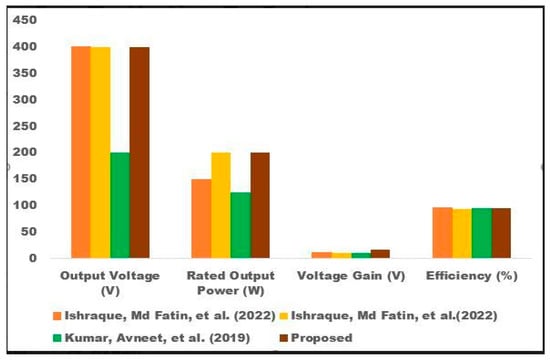
Figure 13.
Comparison of the proposed converter with existing converters [9,10,20].
8. Power Loss and Efficiency Calculation
8.1. Switch Loss
Switching and conduction losses are both elements of the power switch losses. The power switches’ lowest current IS_low and highest current IS_high values can be calculated as follows:
The current through S2 is zero when S2 is turned off, and iD2 is the same amount of current flowing through S1. To determine the power switches’ conduction losses by using the following method:
where
where rds1 and rds2 are the power switches’ S1 and S2 respective conduction resistances. The switch S1 is always on; only S2 has a switching loss. The switching loss can be expressed by (40) and (43), respectively:
where ton and toff are the rising time and falling time of S2. The switching losses are represented by (44).
8.2. Diode Losses
The conduction losses of D2 are determined by (46) as
where Vf2 and rD2 are the conduction voltage drop and conduction resistance of D2. The total diode losses can be calculated using the same approach for D4 and D5.
8.3. Inductor Losses
The RMS current flowing through S2 and the primary is equal when S2 is turned on. The secondary conduction loss can be calculated as
where rLp is the primary conduction resistance. Additionally, the secondary conduction loss can be derived as
where rLs is the secondary conduction resistance. The following equation, which can be expressed as (50), can be stated when S2 is off because the primary conduction loss is equal to PS2_ con _off. The current flowing through the second when S2 is off is equal to the current flowing through D5. The secondary conduction loss may be derived as
The inductor’s overall losses are calculated as
8.4. Capacitor Losses
For simplicity of analysis, C3’s charging and discharging times are divided in half. The capacitors’ conduction losses can be expressed by Equations (52)–(54):
where rC3, rC4, and rCo are the parasitic resistances of C3, C4, and Co, respectively. The capacitor’s total losses are determined as
The proposed converter’s theoretical efficiency can be represented as
where Po is the converter output power.
Figure 14 depicts the distribution of losses. The proposed converter’s efficiency curve is illustrated in Figure 15 with different input sharing conditions at full load. It demonstrates that efficiency rises when the battery port distributes maximum load power. The highest efficiency is 95.8%.
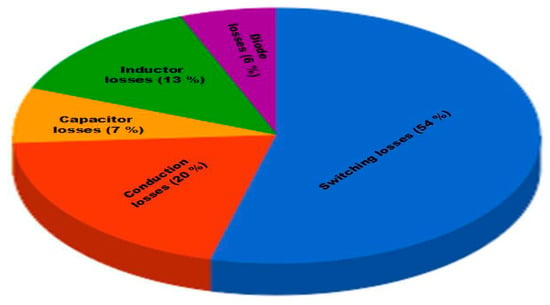
Figure 14.
Distribution of the calculated losses.
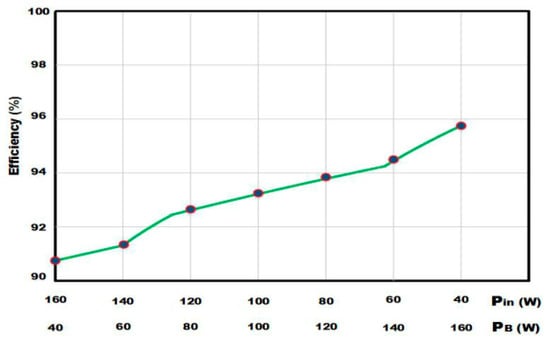
Figure 15.
Proposed converter efficiency with a different input condition.
9. Conclusions
In this work, a multi-port converter with a lower element was proposed for use in renewable energy applications. The voltage gain is increased by coupling an inductor and using switched capacitor techniques. Renewable energy sources have used one port; that port can be used in both directions by an ESS, and a high voltage load can use one port to actualize power flows. Additionally, the power switches’ voltage stresses are clamped while the power from the leakage inductance is reused utilizing the clamp circuit. The efficiency can be further increased with the power switches’ low on-resistances. The proposed converter’s thorough evaluation and analysis were presented. The results of the experiments demonstrate the feasibility of the high-efficiency and step-up voltage gain converter that has been proposed. The convenience, dependability, and MPPT control are merits of the MPC. The maximum measured efficiency of 95.8% was achieved.
Author Contributions
Conceptualization, B.A., G.D., S.S. and S.V.; methodology, B.A., G.D., S.S. and S.V.; formal analysis, B.A., G.D., S.S. and S.V.; investigation and resources, B.A., G.D., S.S. and S.V.; writing—original draft preparation, B.A., G.D., S.S. and S.V.; writing—review and editing B.A., G.D., S.S. and S.V.; visualization, supervision, and project administration, B.A., G.D., S.S. and S.V. All authors have read and agreed to the published version of the manuscript.
Funding
This work was funded by the Research Groups Funding program grant code (NU/RG/SERC/12/7).
Institutional Review Board Statement
Not applicable.
Informed Consent Statement
Not applicable.
Data Availability Statement
Not applicable.
Acknowledgments
The authors are thankful to the Deanship of Scientific Research at Najran University for funding this work under the Research Groups Funding program grant code (NU/RG/SERC/12/7).
Conflicts of Interest
The authors declare no conflict of interest.
References
- Raghavendra, K.V.G.; Zeb, K.; Muthusamy, A.; Krishna, T.N.V.; Kumar, S.V.P.; Kim, D.H.; Kim, H.J. A comprehensive review of DC–DC converter topologies and modulation strategies with recent advances in solar photovoltaic systems. Electronics 2019, 9, 31. [Google Scholar] [CrossRef]
- Alghaythi, M.L.; O’Connell, R.M.; Islam, N.E.; Khan, M.M.S.; Guerrero, J.M. A high step-up interleaved DC-DC converter with voltage multiplier and coupled inductors for renewable energy systems. IEEE Access 2020, 8, 123165–123174. [Google Scholar] [CrossRef]
- Affam, A.; Buswig, Y.M.; Othman, A.K.B.H.; Julai, N.B.; Qays, O. A review of multiple input DC-DC converter topologies linked with hybrid electric vehicles and renewable energy systems. Renew. Sustain. Energy Rev. 2021, 135, 110186. [Google Scholar] [CrossRef]
- Bharathidasan, M.; Indragandhi, V.; Suresh, V.; Jasiński, M.; Leonowicz, Z. A review on electric vehicle: Technologies, energy trading, and cyber security. Energy Rep. 2022, 8, 9662–9685. [Google Scholar] [CrossRef]
- Siddique, M.D.; Ali, J.S.M.; Mekhilef, S.; Mustafa, A.; Sandeep, N.; Almakhles, D. Reduced switch count based single source 7L boost inverter topology. IEEE Trans. Circuits Syst. II Express Briefs 2020, 67, 3252–3256. [Google Scholar] [CrossRef]
- Arun, V.; Kannan, R.; Ramesh, S.; Vijayakumar, M.; Raghavendran, P.S.; Siva Ram, M.; Anbarasu, P.; Sundramurthy, V.P. Review on Li-Ion Battery vs Nickel Metal Hydride Battery in EV. Adv. Mater. Sci. Eng. 2022, 2022, 7910072. [Google Scholar] [CrossRef]
- Wang, Z.; Luo, Q.; Wei, Y.; Mou, D.; Lu, X.; Sun, P. Topology analysis and review of three-port DC–DC converters. IEEE Trans. Power Electron. 2020, 35, 11783–11800. [Google Scholar] [CrossRef]
- Tseng, K.C.; Chang, S.Y.; Cheng, C.A. Novel isolated bidirectional interleaved converter for renewable energy applications. IEEE Trans. Ind. Electron. 2020, 66, 9278–9287. [Google Scholar] [CrossRef]
- Ishraque, M.F.; Rahman, A.; Shezan, S.; Muyeen, S. Grid Connected Microgrid Optimization and Control for a Coastal Island in the Indian Ocean. Sustainability 2022, 14, 16697. [Google Scholar] [CrossRef]
- Ishraque, M.F.; Rahman, A.; Shezan, S.A.; Shafiullah, G. Operation and Assessment of a Microgrid for Maldives: Islanded and Grid-Tied Mode. Sustainability 2022, 14, 15504. [Google Scholar] [CrossRef]
- Sarker, S.K.; Uddin, M.; Tania, M.; Das, S.; Ishraque, M.; Shezan, S.A. A new decentralized two-stage multi-objective control of secondary network driven hybrid microgrid under variable generation and load conditions. Energy Rep. 2022, 8, 14154–14169. [Google Scholar] [CrossRef]
- Shezan, S.A.; Ishraque, M.F.; Muyeen, S.M.; Abu-Siada, A.; Saidur, R.; Ali, M.M.; Rashid, M.M. Selection of the best dispatch strategy considering techno-economic and system stability analysis with optimal sizing. Energy Strategy Rev. 2022, 43, 100923. [Google Scholar] [CrossRef]
- Shezan, S.A.; Kamwa, I.; Ishraque, M.F.; Muyeen, S.M.; Hasan, K.N.; Saidur, R.; Rizvi, S.M.; Shafiullah, M.; Al-Sulaiman, F.A. Evaluation of Different Optimization Techniques and Control Strategies of Hybrid Microgrid: A Review. Energies 2023, 16, 1792. [Google Scholar] [CrossRef]
- Rajesh, R.; Karthik, R.; Elango, K. Grid-Connected Hybrid Based Multi-Input Transformer-Coupled Bidirectional DC-DC Converter. i-Manag. J. Power Syst. Eng. 2021, 9, 20. [Google Scholar] [CrossRef]
- Tang, S.; Shelden, D.R.; Eastman, C.M.; Pishdad-Bozorgi, P.; Gao, X. A review of building information modeling (BIM) and the internet of things (IoT) devices integration: Present status and future trends. Autom. Constr. 2019, 101, 127–139. [Google Scholar] [CrossRef]
- Dong, Z.; Li, Z.; Li, X.L.; Chi, K.T.; Zhang, Z. Single-inductor multiple-input multiple-output converter with common ground, high scalability, and no cross-regulation. IEEE Trans. Power Electron. 2020, 36, 6750–6760. [Google Scholar] [CrossRef]
- Ashokkumar, R.; Suresh, M.; Sharmila, B.; Panchal, H.; Gokul, C.; Udhayanatchi, K.V.; Israr, M. A novel method for Arduino based electric vehicle emulator. Int. J. Ambient Energy 2022, 43, 4299–4304. [Google Scholar] [CrossRef]
- Sheela, A.; Suresh, M.; Shankar, V.G.; Panchal, H.; Priya, V.; Atshaya, M.; Dharaskar, S. FEA based analysis and design of PMSM for electric vehicle applications using magnet software. Int. J. Ambient Energy 2022, 43, 2742–2747. [Google Scholar] [CrossRef]
- Aljafari, B.; Ramu, S.K.; Devarajan, G.; Vairavasundaram, I. Integration of photovoltaic-based transformerless high step-up dual-output–dual-input converter with low power losses for energy storage applications. Energies 2022, 15, 5559. [Google Scholar] [CrossRef]
- Kumar, A.; Wang, Y.; Pan, X.; Xiong, X.; Reza, M.M.; Al Jaafari, K. Modified a-source converter operating at lower voltage stress. IEEE Access 2019, 7, 179670–179678. [Google Scholar] [CrossRef]
- Abbasi Aghdam Meinagh, F.; Yuan, J.; Yang, Y. Analysis and design of a high voltage gain quasi Z-source DC–DC converter. IET Power Electron. 2019, 13, 1837–1847. [Google Scholar] [CrossRef]
- Mizani, A.; Ansari, S.A.; Shoulaie, A.; Davidson, J.N.; Foster, M.P. Single-active switch high voltage gain DC–DC converter using a non-coupled inductor. IET Power Electron. 2021, 14, 492–502. [Google Scholar] [CrossRef]
- Rahimi, R.; Habibi, S.; Shamsi, P.; Ferdowsi, M. A High Step-Up Z-Source DC-DC Converter for Integration of Photovoltaic Panels into DC Microgrid. In Proceedings of the 2021 IEEE Applied Power Electronics Conference and Exposition (APEC), Phoenix, AZ, USA, 14–17 June 2021; pp. 1416–1420. [Google Scholar]
- HoseinzadehLish, M.; Ebrahimi, R.; MadadiKojabadi, H.; Guerrero, J.M.; NouraniEsfetanaj, N.; Chang, L. Novel high gain DC–DC converter based on coupled inductor and diode capacitor techniques with leakage inductance effects. IET Power Electron. 2020, 13, 2380–2389. [Google Scholar] [CrossRef]
- Deng, J.; Wang, H.; Shang, M. A ZVS three-port DC/DC converter for high-voltage bus-based photovoltaic systems. IEEE Trans. Power Electron. 2019, 34, 10688–10699. [Google Scholar] [CrossRef]
- Wu, Y.E.; Hsu, K.C. Novel three-port bidirectional DC/DC converter with three-winding coupled inductor for photovoltaic system. Energies 2020, 13, 1132. [Google Scholar] [CrossRef]
- Faraji, R.; Farzanehfard, H.; Esteki, M.; Khajehoddin, S.A. A lossless passive snubber circuit for three-port DC–DC converter. IEEE J. Emerg. Sel. Top. Power Electron. 2020, 9, 1905–1914. [Google Scholar] [CrossRef]
- Al-Soeidat, M.R.; Aljarajreh, H.; Khawaldeh, H.A.; Lu, D.D.C.; Zhu, J. A reconfigurable three-port DC–DC converter for integrated PV-battery system. IEEE J. Emerg. Sel. Top. Power Electron. 2019, 8, 3423–3433. [Google Scholar] [CrossRef]
- Rostami, S.; Abbasi, V.; Talebi, N.; Kerekes, T. Three-port DC–DC converter based on quadratic boost converter for stand-alone PV/battery systems. IET Power Electron. 2020, 13, 2106–2118. [Google Scholar] [CrossRef]
- Jalilzadeh, T.; Rostami, N.; Babaei, E.; Hosseini, S.H. Multiport DC–DC converter with step-up capability and reduced voltage stress on switches/diodes. IEEE Trans. Power Electron. 2020, 35, 11902–11915. [Google Scholar] [CrossRef]
- Kim, S.; Nam, H.T.; Cha, H.; Kim, H.G. Investigation of self-output voltage balancing in input-parallel output-series DC–DC converter. IEEE J. Emerg. Sel. Top. Power Electron. 2019, 8, 2850–2860. [Google Scholar] [CrossRef]
- Almutairi, A.; Sayed, K.; Albagami, N.; Abo-Khalil, A.G.; Saleeb, H. Multi-Port PWM DC-DC Power Converter for Renewable Energy Applications. Energies 2021, 14, 3490. [Google Scholar] [CrossRef]
- Li, X.L.; Dong, Z.; Chi, K.T.; Lu, D.D.C. Single-inductor multi-input multi-output DC–DC converter with high flexibility and simple control. IEEE Trans. Power Electron. 2020, 35, 13104–13114. [Google Scholar] [CrossRef]
- Elshora, A.; Elsayed, Y.; Gabbar, H.A. Modular Bidirectional Converter with Multiple Power Sources for Fast Charging of Electric Vehicles. In Proceedings of the 2021 IEEE 9th International Conference on Smart Energy Grid Engineering (SEGE), Oshawa, ON, Canada, 11–13 August 2021; pp. 141–146. [Google Scholar]
- Shoaei, A.; Abbaszadeh, K.; Allahyari, H. A Single-Inductor Multi-Input Multi-Level High Step-Up DC-DC Converter Based on Switched-Diode-Capacitor Cells for PV Applications. IEEE J. Emerg. Sel. Top. Ind. Electron. 2023, 4, 18–27. [Google Scholar] [CrossRef]
- Faraji, R.; Adib, E.; Farzanehfard, H. Soft-switched non-isolated high step-up multi-port DC-DC converter for hybrid energy system with minimum number of switches. Int. J. Electr. Power Energy Syst. 2019, 106, 511–519. [Google Scholar] [CrossRef]
- Faraji, R.; Farzanehfard, H. Fully soft-switched multiport DC–DC converter with high integration. IEEE Trans. Power Electron. 2020, 36, 1901–1908. [Google Scholar] [CrossRef]
- Bhattacharjee, A.K.; Kutkut, N.; Batarseh, I. Review of multiport converters for solar and energy storage integration. IEEE Trans. Power Electron. 2018, 34, 1431–1445. [Google Scholar] [CrossRef]
- Arif, M.; Shahzad, M.; Li, Q.; Saleem, J.; Aslam, M.S.; Majid, A. Single Magnetic Element-Based High Step-Up Converter for Energy Storage and Photovoltaic System with Reduced Device Count. Complexity 2020, 2020, 5892190. [Google Scholar] [CrossRef]
- Mirlohi, S.H.; Yazdani, M.R.; Adib, E.; Amini, M.R. Non-isolated high step-up dual input DC-DC converter with zero voltage transition. Int. J. Circuit Theory Appl. 2020, 48, 762–776. [Google Scholar] [CrossRef]
- Jalilzadeh, T.; Rostami, N.; Babaei, E.; Maalandish, M. Ultra-step-up dc–dc converter with low-voltage stress on devices. IET Power Electron. 2019, 12, 345–357. [Google Scholar] [CrossRef]
- Moury, S.; Lam, J. A soft-switched, multiport photovoltaic power optimizer with integrated storage interface and output voltage regulation. IEEE Trans. Ind. Electron. 2020, 68, 3917–3927. [Google Scholar] [CrossRef]
- Saadatizadeh, Z.; ChavoshipourHeris, P.; Babaei, E.; Blaabjerg, F.; Cecati, C. SIDO coupled inductor-based high voltage conversion ratio DC–DC converter with three operations. IET Power Electron. 2021, 14, 1735–1752. [Google Scholar] [CrossRef]
- Dhananjaya, M.; Pattnaik, S. Design and implementation of a SIMO DC–DC converter. IET Power Electron. 2019, 12, 1868–1879. [Google Scholar] [CrossRef]
- Narayanaswamy, J.; Mandava, S. Non-Isolated Multiport Converter for Renewable Energy Sources: A Comprehensive Review. Energies 2023, 16, 1834. [Google Scholar] [CrossRef]
- Varaprasad, M.V.; Ramakrishna, N.S.S.; Kamwa, I.; Venkatesan, M.; Swamy, D.M.; Muyeen, S.M.; Shezan, S.A.; Ishraque, M.F. Design and analysis of PV fed high-voltage gain DC-DC converter using PI and NN controllers. Ain Shams Eng. J. 2022, 14, 102061. [Google Scholar] [CrossRef]
- Ahmed, M.; Abdelrahem, M.; Kennel, R.; Hackl, C.M. An enhanced maximum power point tracking based finite-control-set model predictive control for PV systems. In Proceedings of the 2020 11th Power Electronics, Drive Systems, and Technologies Conference (PEDSTC), Tehran, Iran, 4–6 February 2020; pp. 1–6. [Google Scholar]
- Yang, Y.; Wen, H. Adaptive perturb and observe maximum power point tracking with current predictive and decoupled power control for grid-connected photovoltaic inverters. J. Mod. Power Syst. Clean Energy 2019, 7, 422–432. [Google Scholar] [CrossRef]
- Jotham Jeremy, L.; Ooi, C.A.; Teh, J. Non-isolated conventional DC-DC converter comparison for a photovoltaic system: A review. J. Renew. Sustain. Energy 2020, 12, 013502. [Google Scholar] [CrossRef]
- Eltamaly, A.M.; Al-Saud, M.S.; Abokhalil, A.G. A novel scanning bat algorithm strategy for maximum power point tracker of partially shaded photovoltaic energy systems. Ain Shams Eng. J. 2020, 11, 1093–1103. [Google Scholar] [CrossRef]
- Ramaprabha, R.; Ramya, G. Global MPP Tracking for Partial shaded PV System using Fractional Order Extreme Seeking controller. IOP Conf. Ser. Mater. Sci. Eng. 2020, 937, 012009. [Google Scholar] [CrossRef]
- Bharathidasan, M.; Indragandhi, V. Implementation of Radial Basis Function Network-Based Maximum Power Point Tracking for PV Fed High Step-Up Converter. Front. Energy Res. 2022, 10, 915730. [Google Scholar] [CrossRef]
- Thankachan, J.; Singh, S.P. A multiport solar-assisted SRM drive for HEV applications. In Proceedings of the 2019 IEEE Power and Energy Conference at Illinois (PECI), Champaign, IL, USA, 28 February–1 March 2019; pp. 1–6. [Google Scholar]
- Rasappan, S.K.; Williams, R.B.; Muthusamy, S.; Pandiyan, S.; Panchal, H.; Meena, R.S. A Novel ultra sparse matrix converter as a power transferring device for gearless wind energy conversion systems based on renewable energy applications. Sustain. Energy Technol. Assess. 2022, 50, 101830. [Google Scholar] [CrossRef]
- Siva Ramkumar, M.; Felshiya Rajakumari, R.; Kannan, N.; Premkumar, R.; Mohanasundaram, S.; Purushotham, S.; Rajan, K. Semiconductor Materials for Solar PV Technology and Challenges towards Electrical Engineering. Adv. Mater. Sci. Eng. 2022, 2022, 7272489. [Google Scholar] [CrossRef]
- Guepfrih, M.F.; Waltrich, G.; Lazzarin, T.B. High step-up DC-DC converter using built-in transformer voltage multiplier cell and dual boost concepts. IEEE J. Emerg. Sel. Top. Power Electron. 2021, 9, 6700–6712. [Google Scholar] [CrossRef]
- Sayed, K.; Ali, Z.M.; Aldhaifallah, M. Phase-Shift PWM-Controlled DC–DC Converter with Secondary-Side Current Doubler Rectifier for On-Board Charger Application. Energies 2020, 13, 2298. [Google Scholar] [CrossRef]
- Sayed, K.; Gronfula, M.G.; Ziedan, H.A. Novel soft-switching integrated boost DC-DC converter for PV power system. Energies 2020, 13, 749. [Google Scholar] [CrossRef]
- Badar, M.; Ahmad, I.; Mir, A.A.; Ahmed, S.; Waqas, A. An autonomous hybrid DC microgrid with ANN-fuzzy and adaptive terminal sliding mode multi-level control structure. Control Eng. Pract. 2022, 121, 105036. [Google Scholar] [CrossRef]
Disclaimer/Publisher’s Note: The statements, opinions and data contained in all publications are solely those of the individual author(s) and contributor(s) and not of MDPI and/or the editor(s). MDPI and/or the editor(s) disclaim responsibility for any injury to people or property resulting from any ideas, methods, instructions or products referred to in the content. |
© 2023 by the authors. Licensee MDPI, Basel, Switzerland. This article is an open access article distributed under the terms and conditions of the Creative Commons Attribution (CC BY) license (https://creativecommons.org/licenses/by/4.0/).